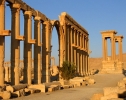Palmyra is an amazing old city in the middle of Syrian Badia (semi- desert). It is one of Syria’s most famous places to visit. It has a unique location. It is 245 kilometers from Damascus, 160 km from Homs and 220 km from Der Ezzour. It was once a great city on the road from Europe to India and China.
Palmyra has several archaeological and tourist sites, which flourished and developed in the old days. The visitor can look at the ruins of its buildings, the market and the fantastic theater. Palmyra has become a paradise for tourists and the number one destination for those who have interest in art and civilization. The Roman called the city Palmyra “Oasis of Palms”. It is also called now “Pearl of the Desert”. The more you see Palmyra, the more you are enchanted by its treasures.
Palmyra and its Badia are of great importance in the economic, tourist and archaeological domains. The city is also significant in supporting the agricultural sector including breeding and developing livestock dairy production.
The government has exerted efforts to make the Badia a main area for animal breeding and increasing income for the local community. Investing the Badia in an ideal way will help in supporting national economy.
Palmyra has started to carry out projects concerning protecting and maintaining the Badia and investing its rich resources. The importance of the Badia lies in changing it into a rich area with genetic, animal and plant origins and finding an income that can support tourism revenues of Palmyra city.
The population of Palmyra is estimated at 390,000. This area includes 50 villages and farms. Residents of Palmyra, thanks to their activities, in those days enjoy a privileged existence living on the crossroads between east and west. The city of Palmyra is now linked by road to other cities and this helps visitors to visit the unique site when touring the country.
The city is surrounded by pasture land and agriculture covers 850’000 hectares and forest areas are estimated at 100.000 hectares whereas there are 3 million hectares of grassland and pastures. There are 50 farming association in Palmyra and the members own 1, 5 million of sheep and 2800 camels.
The city is surrounded by an oasis of palm trees, olives trees 400,000 and pomegranates covering an estimated area estimated of 1,ooo hectares. The annual revenue of these trees ranges between 100 and 150 million Syrian pounds.
Palmyra also contains several natural resources such as phosphate; the annual production is estimated at 2, 5 million tones at al- Sowaneh and Khneifees in addition to marble and reserves of oil and gas.
The government is interested in setting up several ventures such as establishing a free tourism city, international airport and constructing large service centers in addition to other projects. These future plans will help to ensure the city of Palmyra to become a vital and effective center and important tourist destination.
Sharif Al-Khatib

